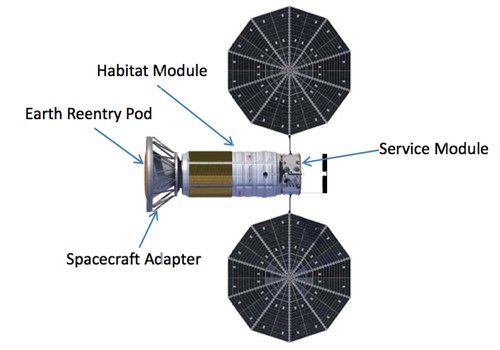
Illustration of the Inspiration Mars Vehicle Stack, the spacecraft that would take two people on a Mars flyby mission. It makes use of a modified Cygnus spacecraft as the habitat module and a Orion spacecraft with enhanced heat shield to return the crew to Earth. (credit: Inspiration Mars)
Inspiration Mars, the private effort announced earlier this year by Dennis Tito to mount a human Mars flyby mission, is now looking to partner more closely with NASA to use its launch vehicles and technologies—and, presumably, its funding—to make the mission possible.
The Inspiration Mars Foundation is releasing today a 60-day report on its Mars mission architecture, tied to testimony that Tito plans to give at a hearing of the space subcommittee of the House Science Committee on commercial space. The report lays out the “baseline architecture” for the proposed mission, which would launch in late December of 2017 or early January 2018 on a 501-day mission to fly past Mars and return to Earth.
The architecture makes use of a mix of commercial and government vehicles and spacecraft. First, a Space Launch System (SLS) heavy-lift rocket, flying on its first mission, would place into orbit the “Vehicle Stack”, consisting of a modified Cygnus spacecraft from Orbital Sciences Corporation that would serve as the crew habitat and a “Earth Reentry Pod,” an Orion spacecraft with an upgraded heat shield that can handle the high-speed reentry when the crew returns to Earth. That Vehicle Stack would be launched with a Dual Use Upper Stage (DUUS) that has been proposed for development to enhance the SLS’s performance. Once in orbit, a commercial crew vehicle would launch and dock with the Vehicle Stack, transferring over the two-person crew, then depart. The DUUS then ignites its engines to place the Vehicle Stack on its Mars flyby trajectory. Upon return to Earth, the crew boards the Earth Reentry Pod and undocks from the Vehicle Stack for reentry and splashdown.
Accomplishing this mission would require accelerating development of some key systems, like the DUUS, and developing new ones, like the Cygnus-based habitat module, in a short timeframe: the launch window for this opportunity opens on Christmas Eve of 2017 and closes less than two weeks later, on January 4, 2018. It also means that systems under development today, like the SLS and commercial crew vehicles, have to remain on schedule; already, the timeline for commercial crew vehicles have slipped from 2015 to 2017 because of funding shortfalls. The DUUS is not expected to be available until 2023, according to a NASA document published in April; the Inspiration Mars report says that “extensive discussions” with NASA and Boeing led them to conclude the DUUS could be accelerated to be ready to support this mission.
The report pitches this mission as a public-private partnership that would benefit NASA at least as much as it does Inspiration Mars. “For America, this is our last chance to be first, and even the very movement of planets seems to be saying ‘Go,’” the report states, referring to the favorable trajectory that makes this mission possible at the beginning of 2018 but not again for 15 more years. “The Inspiration Mars spacecraft has to be on its way to Mars in the first days of 2018, if this mission is to happen at all. And if it does not happen, then where does that leave human space exploration by the United States?”
Having NASA support the mission, the report argues, accelerates the agency’s own long-term plans for human Mars missions. “It will not be any easier, or any cheaper, to do in 20 years what can be done in five,” the report states. “By doing it now, moreover, we expand the range of what can be achieved and learned in the 2020’s and 2030’s.”
One area the report doesn’t go into detail about is the cost of the mission. It does acknowledge that the partnership with NASA would require some additional federal spending: “perhaps several hundred million dollars,” it states, a sum it equates with the total expense of moving the Space Shuttle orbiters to museums. It would, though, seek to redirect current NASA spending on programs like SLS and Orion to support the mission: the unit cost of a single SLS, for example, has been estimated by NASA at $500–600 million alone. “More than any new federal funding for this mission – some might be needed, but not much – what NASA would require to carry out its part of the work is the freedom to direct existing funds to the enterprise,” the report argues. “This is a freedom that Congress can grant and the President can assure, as John F. Kennedy did to clear the bureaucratic path for Apollo.” And something he will likely be asking Congress to support today.

Nice write-up Jeff. I hope that the SLS is ready by then, and that just the perception that the mission is too risky would not make it a non-starter. Presumably, it would also have to be supported by the next administration.
I understand that NASA has now declared that they cannot financially support this mission.
Mr. Tito is reported to have said he may well now approach Russia and/or the Chinese…!
I just can’t see how going to either of them will meet with the original mission objective, “inspire the next generation of americans”.
Sorry to say it, it looks like the “party’s” over.
“Mr. Tito is reported to have said he may well now approach Russia and/or the Chinese…!”
Based on comments he made at Wednesday afternoon’s press conference, that statement is not correct. Tito believes that Russia or China could do such a mission on their own (although with very limited evidence to support that assertion), but was not interested in cooperating with them. After all, Inspiration Mars is billed as “a mission for America”!